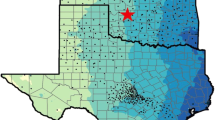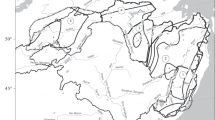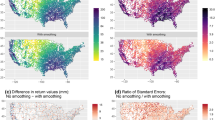Abstract
A main task of weather services is the issuing of warnings for potentially harmful weather events. Automated warning guidances can be derived, e.g., from statistical post-processing of numerical weather prediction using meteorological observations. These statistical methods commonly estimate the probability of an event (e.g. precipitation) occurring at a fixed location (a point probability). However, there are no operationally applicable techniques for estimating the probability of precipitation occurring anywhere in a geographical region (an area probability). We present an approach to the estimation of area probabilities for the occurrence of precipitation exceeding given thresholds. This approach is based on a spatial stochastic model for precipitation cells and precipitation amounts. The basic modeling component is a non-stationary germ-grain model with circular grains for the representation of precipitation cells. Then, we assign a randomly scaled response function to each precipitation cell and sum these functions up to obtain precipitation amounts. We derive formulas for expectations and variances of point precipitation amounts and use these formulas to compute further model characteristics based on available sequences of point probabilities. Area probabilities for arbitrary areas and thresholds can be estimated by repeated Monte Carlo simulation of the fitted precipitation model. Finally, we verify the proposed model by comparing the generated area probabilities with independent rain gauge adjusted radar data. The novelty of the presented approach is that, for the first time, a widely applicable estimation of area probabilities is possible, which is based solely on predicted point probabilities (i.e., neither precipitation observations nor further input of the forecaster are necessary). Therefore, this method can be applied for operational weather predictions.






Similar content being viewed by others
Notes
The GME has been substituted in January 2015 by the Icosahedral Non-hydrostatic (ICON) General Circulation Model, see Zängl et al. (2015).
For beta prime and inverse gamma distribution only those parameter configurations are considered that lead to a finite variance.
References
Chiu SN, Stoyan D, Kendall WS, Mecke J (2013) Stochastic geometry and its applications, 3rd edn. Wiley, Chichester
Daan H (1985) Sensitivity of verification scores to the classification of the predictand. Mon Weather Rev 113:1384–1392
Epstein SE (1966) Point and area precipitation probabilites. Mon Weather Rev 94–10:595–598
Illian J, Penttinen A, Stoyan H, Stoyan D (2008) Statistical analysis and modelling of spatial point patterns. Wiley, Chichester
Knüpffer K (1996) Methodical and predictability aspects of MOS systems. In: 13th conference on probability and statistics in atmosphere sciences. Amer. Meteorol. Soc., San Francisco, CA, pp 190–197
Koubek A, Pawlas Z, Brereton T, Kriesche B, Schmidt V (2016) Testing the random field model hypothesis for random marked closed sets. Spat Stat 16:118–136
Kriesche B, Hess R, Reichert BK, Schmidt V (2015) A probabilistic approach to the prediction of area weather events, applied to precipitation. Spat Stat 12:15–30
Kriesche B, Koubek A, Pawlas Z, Beneš V, Hess R, Schmidt V (2015) A model-based approach to the computation of area probabilities for precipitation exceeding a certain threshold. In: Proceedings of the 21st international congress on modelling and simulation. Modelling and Simulation Society of Australia and New Zealand, Gold Coast, pp 2103–2109
Krzysztofowicz R (1998) Point-to-area rescaling of probabilistic quantitative precipitation forecasts. J Appl Meteorol 38:786–796
Lanza LG (2000) A conditional simulation model of intermittent rain fields. Hydrol Earth Syst Sci 4(1):173–183
Lawson CL, Hanson RJ (1974) Solving least squares problems. Prentice-Hall, Englewood Cliffs
Majewski D, Liermann D, Prohl P, Ritter B, Buchhold M, Hanisch T, Paul G, Wergen W, Baumgardner J (2002) The global icosahedral-hexagonal grid point model GME: description and high-resolution tests. Mon Weather Rev 130(2):319–338
Mayer J, Schmidt V, Schweiggert F (2004) A unified simulation framework for spatial stochastic models. Simul Model Pract Theory 12(5):307–326
Onof CJ, Chandler RE, Kakou A, Northrop PJ, Wheater HS, Isham VS (2000) Rainfall modelling using Poisson-cluster processes: a review of developments. Stoch Environ Res Risk Assess 14(6):384–411
Rodriguez-Iturbe I, Cox DR, Eagleson PS (1986) Spatial modelling of total storm rainfall. Proc R Soc Lond A 403(1824):27–50
Sivapalan M, Wood EF (1987) A multidimensional model of nonstationary space-time rainfall at the catchment scale. Water Resour Res 23(7):1289–1299
Smith JA, Krajewski WF (1987) Statistical modeling of space-time rainfall using radar and rain gage observations. Water Resour Res 23(10):1893–1900
Wheater HS, Chandler RE, Onof CJ, Isham VS, Bellone E, Yang C, Lekkas D, Lourmas G, Segond M-L (2005) Spatial-temporal rainfall modelling for flood risk estimation. Stoch Environ Res Risk Assess 19(6):403–416
Wilks DS (1995) Statistical methods in the atmospheric sciences, 3rd edn. Academic Press, San Diego
Wilks DS, Eggleston KL (1992) Estimating monthly and seasonal precipitation distributions using the 30- and 90-day outlooks. J Clim 10:77–83
Winterrath T, Rosenow W, Weigl E (2012) On the DWD quantitative precipitation analysis and nowcasting system for real-time application in German flood risk management. In: Moore RJ, Cole SJ, Illingworth AJ (eds) Weather radar and hydrology (proceedings of a symposium held in Exeter, UK, April 2011), vol IAHS 351, pp 323–329 (2012)
Yang C, Chandler RE, Isham VS, Wheater HS (2005) Spatial-temporal rainfall simulation using generalized linear models. Water Resour Res 41:W11415–W11428
Zängl G, Reinert D, Rípodas P, Baldauf M (2015) The ICON (ICOsahedral Non-hydrostatic) modelling framework of DWD and MPI-M: description of the non-hydrostatic dynamical core. Q J R Meteorol Soc 141:563–579
Acknowledgments
The authors gratefully acknowledge the financial supports from the German Academic Exchange Service (DAAD) and the Czech Ministery of Education, project 7AMB14DE006. Antonín Koubek was supported by the Grant SVV-2015-260225.
Author information
Authors and Affiliations
Corresponding author
Appendix
Appendix
We give a brief derivation of Eqs. (6) and (7) for the conditional expectation and variance of the random precipitation amount \(\Gamma _t\) at \(t \in W\) given \(\{E=e\}\). In order to derive (7), we need the following general result for Poisson processes. Let \(\{Y_i, i=1,2,\ldots \}\) be a Poisson process in \(\mathbb {R}^2\) with locally integrable intensity function \(\lambda :\mathbb {R}^2 \rightarrow [0, \infty )\), second-order moment measure \(\mu ^{(2)}:\mathcal {B}(\mathbb {R}^2 \times \mathbb {R}^2) \rightarrow [0,\infty ]\) and second-order product density \(\varrho ^{(2)}:\mathbb {R}^2 \times \mathbb {R}^2 \rightarrow [0,\infty )\). Furthermore, let \(f,g:\mathbb {R}^2 \rightarrow [0,\infty )\) be two nonnegative measurable functions. By using the definition of the second-order moment measure and the result that \(\varrho ^{(2)}(x,y)=\lambda (x)\lambda (y)\) for \(x,y \in \mathbb {R}^2\), see e.g. Illian (2008), p. 119, we get
We start with Eq. (6) for the conditional expectation \(\mathbb {E}(\Gamma _t\,|\,E=e)\) of \(\Gamma _t\) given \(\{E=e\}\). In the following, we again use the notation introduced in Sect. 4, i.e., let \(a_j = \mathbb {E}(A_j\,|\,E=e)\), \(c_j = \mathbb {E}(C_j \,|\,E=e)\) and \(\tilde{c}_j = \text{ var }(C_j \,|\,E=e)\) for \(j=1, \ldots ,n\) and \(r=\mathbb {E}(R\,|\,E=e)\). Recall that conditioned on \(\{E=e\}\) the point process \(\{X_i, i =1, \ldots , Z\}\) is a Poisson process with intensity function \(\{\lambda _t, t \in W\}\), where \(\lambda _t = \sum _{j=1}^{n} a_j I_{V(s_j)}(t)\) for all \(t \in W\). Furthermore, \(\{X_i, i =1, \ldots , Z\}\) is conditionally independent of the scaling variables \(C_1, \ldots , C_n\) given \(\{E=e\}\). By applying the Campbell theorem for point processes (see e.g. Chiu (2013), Theorem 4.1) we get
Now, we consider the conditional variance \(\text{ var }(\Gamma _t \,|\, E=e)\) for a fixed \(t \in W\). To simplify the notation we introduce the function \(f_j:\mathbb {R}^2 \rightarrow [0,\infty )\) with \(f_j(x) = I_{V(s_j)}(x)K_p(t,x,r)\) for all \(x \in \mathbb {R}^2\) and \(j=1, \ldots ,n\). Obviously, \(f_j(x)f_k(x)=0\) for all \(x \in \mathbb {R}^2\) if \(j\ne k\). Furthermore, \(\int f_j(x)\,\text{d}x = I(s_j,t)\) and \(\int f_j^2(x)\,\text{d}x = \tilde{I}(s_j,t)\) for \(j=1, \ldots ,n\), where \(I(s_j,t)\) and \(\tilde{I}(s_j,t)\) are defined according to Eqs. (8) and (9). By using the result for Poisson processes shown before and that conditioned on \(\{E=e\}\), the scaling variables \(C_1, \ldots , C_n\) are independent of each other and of \(\{X_i, i=1, \ldots , Z\}\), we get that
Moreover, according to Eq. (6), we get
Finally, combining both representation formulas results in
which coincides with the representation formula for the conditional variance of \(\Gamma _t\) given in (7).
Rights and permissions
About this article
Cite this article
Kriesche, B., Koubek, A., Pawlas, Z. et al. On the computation of area probabilities based on a spatial stochastic model for precipitation cells and precipitation amounts. Stoch Environ Res Risk Assess 31, 2659–2674 (2017). https://doi.org/10.1007/s00477-016-1321-8
Published:
Issue Date:
DOI: https://doi.org/10.1007/s00477-016-1321-8




